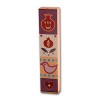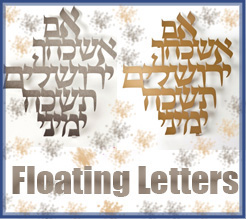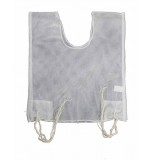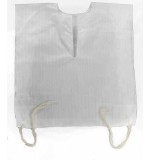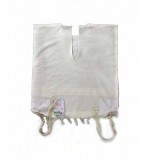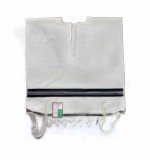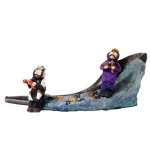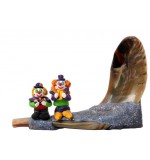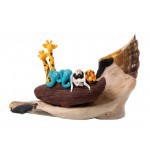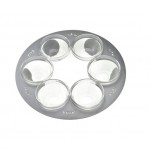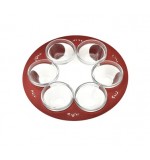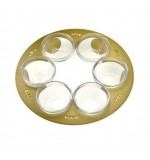tefillin
What are Tefillin?
Tefillin are two leather boxes (Battim) inside of which lie pieces of parchment inscribed with four different portions from the Torah (Parshiot). Leather straps are attached to the battim.
One of these battim is called `Tefillin shel Yad`; it is secured to the arm by winding the straps around the arm. The second of the battim is called `Tefillin shel Rosh`. After the Tefillin shel Yad are positioned, one lays the Tefillin shel Rosh which is likewise fastened to the head with the straps.
The Torah portions written in the Tefillin shel Yad are all written on one parchment (Diagram 1). However in the Tefillin shel Rosh each Torah portion is written on a separate parchment so that each portion can be put inside one of the four compartments of the Tefillin shel Rosh (Diagram 2).
The four Torah portions written on the parchment of Tefillin are:
¨ "Sanctify for me every firstborn" (Exodus 13: 1-10)
¨ "And it will be when He will bring you" (Exodus 13: 11-16)
¨ "Hear O Israel" (Deuteronomy 6: 4–10)
¨ "And it will be if you will surely listen" (Deuteronomy 11: 13–21)
The Symbolism of laying Tefillin
The Tefillin symbolize the eternal connection between the Jewish Nation and G-d, their Father in Heaven. They also act as an identifying sign for the person who wears them, that he is a Jew - as it says in the Torah, in the portion of "Sanctify for me every firstborn" (which is one of the four portions that appear in the Tefillin): "and it shall be for you as a sign on your arm as a remembrance between your eyes, in order that the Torah of G-d should be in your mouth".
Furthermore, the method of putting on the Tefillin acts as a clear symbol of a person’s complete subservience to his G-d: The Tefillin shel Rosh are placed on the head, since the head symbolizing intellect, thoughts and reasoning. Placing Tefillin on the head shows that the person is subjecting his mind and his thoughts to the Creator of the world and His Torah. The Tefillin shel yad are put onto the arm, which symbolizes his strength, actions and deeds.
When is Tefillin worn?
It is the custom to wear Tefillin throughout the entire morning prayers during the week. Being that the law of laying Tefillin has its source in the Torah verse: "and bind them as a sign on your hand, and they should be as Tefillin between your eyes"; Tefillin are not laid on Shabbat or the Festivals. The reason for this is that the commandment of Shabbat is also mentioned with the word "sign", as it is written "and the Children of Israel should keep the Shabbat to make the Shabbat for their generations a covenant for eternity, between Me and between the Children of Israel it is a sign forever" (Exodus 31).
The same applies with regards to the Festivals, which are similar in nature to Shabbat – just as we don’t put ‘a sign on a sign’ [ie, the sign of Tefillin on the sign of Shabbat], so it is with the Festivals. On the intermediate days of Passover and Succot (Chol haMoed), some have the custom to lay Tefillin, and some do not lay Tefillin. In Israel, the custom is not to lay Tefillin on these intermediate days.
Who is obligated in this Commandment?
Every Jew is required to lay Tefillin, whether he was born a Jew or converted. The obligation begins as soon as a boy is thirteen years old. In fact, he will usually begin to lay Tefillin shortly before he reaches Bar Mitzvah (13) in order to get used to fulfilling the commandment and to enable him to become familiar with its relevant laws. Women are exempt from the commandment of laying Tefillin.
Types of Tefillin Boxes (battim)
Simple- These battim are made of parchment, painted matt or shiny black, and they usually measure about 2.5 x2.5cm. They usually contain the simplest type of Parshiot, coated with a thin layer of chalk, which even in the best case are not of the most ideal standard of Kashruth (bedi’eved). Their Halachic quality is very low, which is why we don’t market these Tefillin.
Simple ‘Mehudar’– these battim are made of parchment and usually measure at about 3.2 x 3.2cm. Amongst this type there are some which are Kosher at the most ideal Halachic standard (Kosher l’chatchila), whilst some are only bedi’eved.
Dakosanimal skin – ‘one skin’ – These battim are also made of parchment, but on top of the parchment a layer of thin, moist leather is added, and only then are the battim painted. These battim are Kosher l’chatchila.
Blackening the boxes and the straps
The law is that the straps must be black on the outside. The leather of the battim should be black, too. When the straps begin to age and the black dye cracks, peels or fades, it is necessary to repaint them. One needs to pay attention to the place where the knot is tied, and the area that is wound around the hand and fingers since it is known that the paint fades or peels quickly in those areas. The width of the straps should be a minimum of 11mm.
Who writes the Tefillin?
The Tefillin is written by a ‘Sofer Stam’ - a scribe specialized and highly skilled at writing the unique script found in Mezuzot, Tefillin (phylacteries) and Torah Scrolls – the ‘Ksav Ashuri’ (Ashuri script). He is extremely learned in all the many intricate laws involved in the writing, and his extensive knowledge allows him to form each letter with perfect precision, exactly according to Jewish law and in the tradition that has been passed down from Moses, as received on Mt. Sinai.
The Tefillin is written on ‘Shallil’ parchment, produced from the skin of a kosher animal and tanned with lime. The Scribe uses a quill fashioned from a thick feather, which he dips in a deep black ink that has been manufactured exclusively for the purpose of writing in Mezuzot, Tefillin and Torah scrolls. This is exactly how they used to write in the days of the Tanach, and has been the tradition passed down from generation to generation.
After completing his writing, the Scribe then has to ‘crown’ the letters – seven out of the twenty-two letters of the Hebrew alphabet require crowns. A ‘crown’ is made up of three vertical lines extending from the top of the letter (circled in blue in the diagram below); each line ending in a tiny sphere:
On which arm is the Tefillin placed?
The Tefillin shel yad are put onto the ‘faint’ hand, i.e. the weaker hand. This means that if a person performs most actions with his right hand, then that is his stronger hand and he must lay Tefillin on his left hand which is weaker. This is called ‘right-handed Tefillin’.
Similarly, if a person does most actions with his left hand, he lays Tefillin on his weaker hand which is his right one. This is called ‘left-handed Tefillin’.
It is important to wear the appropriate Tefillin as mentioned, since the knot in right-handed Tefillin is in a different place as the knot in the left-handed version, so a right-handed person will not be able to wear left-handed Tefillin in the normal manner, and vice versa.
The source of the law stating that Tefillin are to be laid on the weaker hand, is found in the Torah in the portion of "It will be when He will bring you", where it says "and it will be as a sign on your hand, and it will be as Tefillin between your eyes" (Exodus 13:15). In this verse, the word for `your hand` "ידכה" is written with an extra letter hey "ה" . From here our Sages derive that one needs to lay Tefillin on the weaker hand - יד כהה.
A further reason for laying Tefillin on the weaker hand, is to show that ‘it is not through the power of man that he is strong, but the battle is won by G-d, for a person’s hand is faint and weak to perform any actions be they small or significant, therefore G-d commanded us to lay Tefillin which has the name of G-d inscribed on them, on the weaker hand, to show that the Hand of G-d gives strength to this weak hand.’
Which version of Tefillin to buy?
One fulfills his obligation of laying Tefillin with any version, but one should try to buy Tefillin according to the version and customs of his ancestors, i.e. the custom of his family or the community that is he affiliated with.
